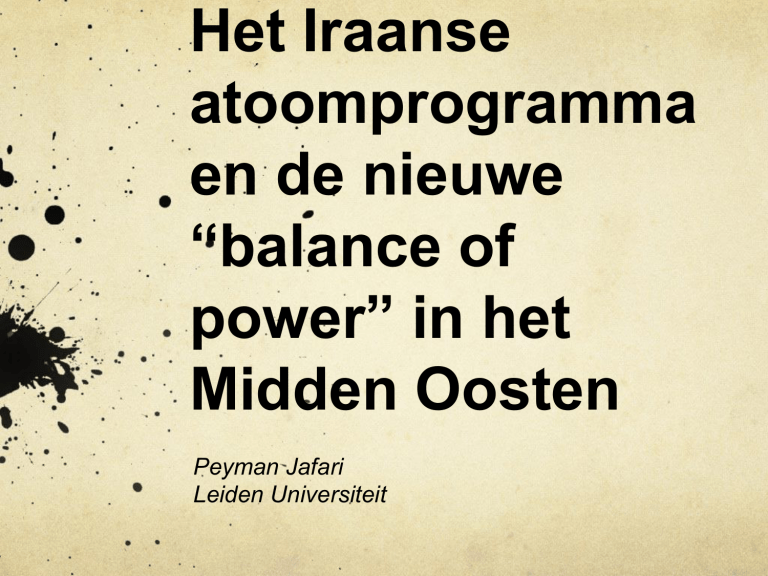
Het Iraanse
atoomprogramma
en de nieuwe
“balance of
power” in het
Midden Oosten
Peyman Jafari
Leiden Universiteit
1967
de VS)
Tijdlijn nucleaire
programma
opening Tehran Onderzoeksreactor (van
1968
Iran tekent het Non-Proliferatieverdrag
1978
verdrag tussen Iran en VS: extra toezicht in
ruil voor “most favored nation” status
Revolutie en oorlog
1995
reactor in
Verdrag Iran en Rusland voor de bouw van
Bushehr (2011)
VS werken Iran’s nucleaire ambities tegen (2000: Iran NonProliferation Act)
2002
Iran’s nucleaire programma wordt onthuld:
Natanz en Arak. Start onderhandelingen
2005
Internationaal Atoom Agentschap verwijst Iran door
VN Veiligheidsraad sancties
2009
Bestaan verrijking in Fordow onthuld
naar
Het conflict
Inspecties: geen bewijs van kernwapenprogramma
Sancties vanaf 2006
Cyberaanvallen
Aanslagen op Iraanse wetenschappers
Oorlogsdreiging
Iran volhardt – Westen voert de druk op
Onderhandelingen en de patstelling:
wat is de kern van het probleem?
Iran een militair gevaar?
De “balance of power”
in het Midden Oosten
Lange termijn factoren
1979 cruciaal: Iran geen steunpillaar maar uitdager
van de Amerikaanse dominantie in het MO
Opkomst Japan en Duitsland en later de BRIClanden, met name China.
Amerikaanse capaciteit van machtsprojectie
economisch afgezwakt, behoudt militaire superioriteit
Het unipolaire moment van de jaren 90 is voorbij.
Olie en gas blijven voornaamste energiebronnen
De “balance of power”
in het Midden Oosten
Korte termijn factoren
Terugtrekking uit Afghanistan en Irak Iran wint invloed
Arabische revoluties: Mubarak (Egypte) en Ben Ali (Tunesie)
Tegenreacties:
Verzwakken Iran (sancties, geheime operaties, proxy-oorlog
Syrië)
Politieke en militaire versterking van de GCC (soennieten
versus sjiieten)
Iran: complexe
beleidvorming
structurele interne crisis: politiek (theocratie
versus democratie), economisch, cultureel
Verschillende machtscentra en fracties, geen
transparantie
de “oorlogsgeneratie” komt op belangrijke
posities.
De Iraanse realpolitik
Karakter van de Iraanse staat en zijn politieke elites
Direct na de revolutie een korte periode van “export van de
revolutie,” maar machtsbehoud wordt dominant
Buitenlandse politiek
Perzische Golf (1981 oprichting GCC)
Rusland en de Kaukasus
De Levant
China
Afrika
VS en Israël
Het nucleaire programma: militaire afschrikking, status,
energie
Iraanse
veiligheidsperceptie
Militaire uitgave 2012 (miljard
dollar)
Iran (25)
Nederland (19)
Israel (17)
VAE (16)
Saoedi-Arabie (8)
VS (1)
0
100.000
200.000
300.000
Amerikaanse
machtsprojectie
“Project Power Despite AntiAccess/Area Denial
Challenges” p4
“In order to credibly deter potential adversaries and
to prevent them from achieving their objectives, the
United States must maintain its ability to project
power in areas in which our access and freedom to
operate are challenged. (…) States such as China
and Iran will continue to pursue asymmetric means
to counter our power projection capabilities, while
the proliferation of sophisticated weapons and
technology will extend to non-state actors as well.
Accordingly, the U.S. military will invest as required
to ensure its ability to operate effectively in antiaccess and area denial (A2/AD) environments.”
Over China
“U.S. economic and security interests are inextricably
linked to developments in the arc extending from the
Western Pacific and East Asia into the Indian Ocean
region and South Asia, creating a mix of evolving
challenges and opportunities. Accordingly, while the U.S.
military will continue to contribute to security globally, we
will of necessity rebalance toward the Asia-Pacific
region.”
“The maintenance of … U.S. influence in this dynamic
region will depend in part on an underlying balance of
military capability and presence. Over the long term,
China’s emergence as a regional power will have the
potential to affect the U.S. economy and our security in a
variety of ways.”
Over Iran
“U.S. policy will emphasize Gulf security, in
collaboration with Gulf Cooperation Council
countries when appropriate, to prevent Iran’s
development of a nuclear weapon capability and
counter its destabilizing policies. (…) To support
these objectives, the United States will continue to
place a premium on U.S. and allied military
presence in and support of partner nations in and
around this region.”
Olie en US National Security
Strategy
“Strategic Resource Access & The Middle East”
“independence from foreign oil is not feasible in one
or two presidential terms. With that in mind, we will
focus on managing our dependence in the short
term. This includes the recognition that for the
foreseeable future we must defend critical
waterways through which global oil supplies travel.
Not only that, but we are also constrained by our
allies’ and adversaries’ dependence on the global oil
supply
Geopolitiek van de oliepijplijnen












